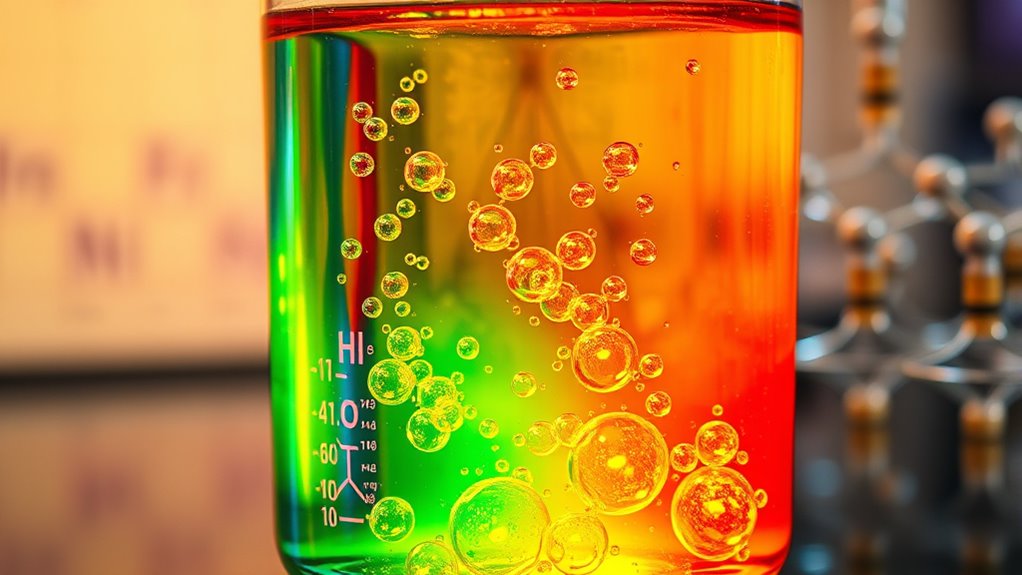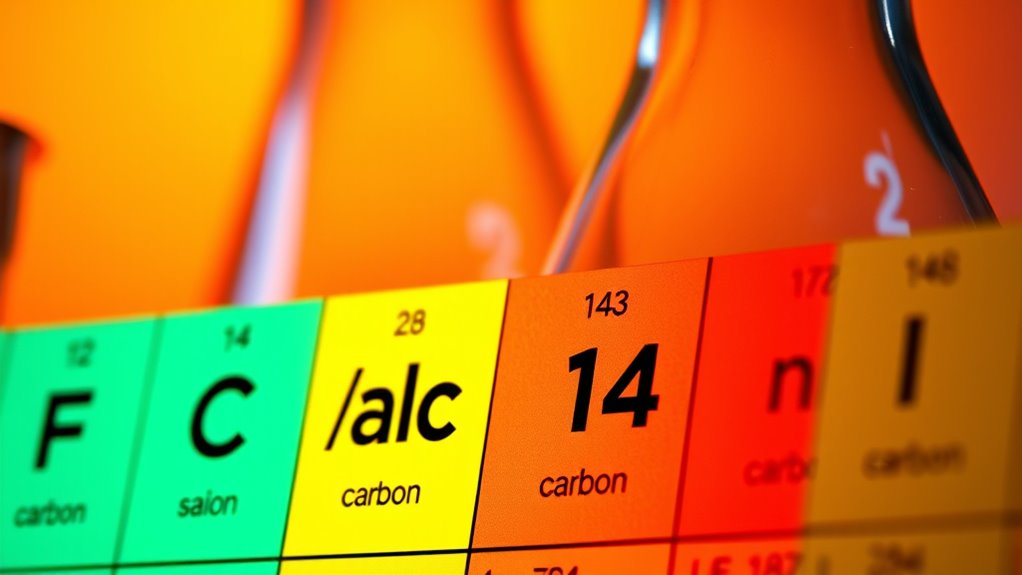Isotopes are variants of elements that share the same number of protons but have different neutrons, affecting their atomic mass and stability. For example, Carbon-12 and Carbon-13 are stable, while Carbon-14 is radioactive. These differences make isotopes useful in fields like medicine, climate study, and nuclear energy. Understanding how isotopes work helps you appreciate their role in science and industry, and if you continue exploring, you’ll discover more about their fascinating applications.
Key Takeaways
- Isotopes are atoms of the same element with identical protons but different neutrons, affecting their mass.
- Examples include Carbon-12, Carbon-13 (stable), and Carbon-14 (radioactive).
- They are essential for dating fossils, studying climate, and medical imaging.
- Natural isotopes form through radioactive decay and cosmic interactions; artificial isotopes are created in labs.
- Isotopes support nuclear energy, medical treatments, environmental monitoring, and scientific research advancements.
Understanding the Basic Definition of Isotopes

Have you ever wondered what makes isotopes special? They’re atoms of the same element that share the same number of protons, which is why they sit in the same spot on the periodic table. However, they differ in the number of neutrons, giving each isotope a different mass number. This means that while the element’s identity stays the same, the atomic mass varies slightly. The term “isotope” comes from Greek, meaning “same place,” highlighting that they occupy the same position in the periodic table. Each isotope is a distinct nuclear species, with only the nucleon count changing. Protons define the element, and neutrons vary, but electrons stay equal to protons in neutral atoms. This difference in neutrons creates various isotopes within a single element. Furthermore, isotopes can be stable or unstable, and this stability influences how they are used in scientific research and practical applications. Additionally, the radioactive nature of unstable isotopes makes them useful in medical imaging and radiometric dating.
The Difference Between Stable and Radioactive Isotopes

Isotopes can be either stable or radioactive, and understanding the difference helps explain their behavior and uses. Stable isotopes don’t decay over time and emit no radiation, while radioactive isotopes are unstable and spontaneously break down, emitting radiation. This difference depends on the balance of neutrons and protons in the nucleus; an imbalance causes instability. For example, carbon-12 and carbon-13 are stable, but carbon-14 is radioactive. Stable isotopes maintain their nuclear composition, making them useful for tracing chemical and biological processes without hazards. Radioactive isotopes, by contrast, decay at measurable rates, which makes them valuable in medical imaging, dating, and nuclear energy. The key distinction lies in stability: one remains constant, the other transforms, releasing energy as it does. Understanding nuclear stability is crucial for grasping how isotopes behave and are applied in various scientific fields.
Common Examples of Isotopes in Everyday Life

Many common household items rely on radioactive isotopes to function safely and effectively. Smoke detectors use Americium-241, which ionizes air to detect smoke particles. When smoke disrupts the current between charged plates, the alarm sounds. Only tiny amounts of Americium-241 are needed, making it safe for household use.
In watches and clocks, tritium gas creates a glow through radioluminescence, helping you read time in the dark. Previously, Promethium-147 served a similar purpose.
Some non-stick cookware is treated with radiation to strengthen coatings, while photocopiers use polonium-210 to neutralize static.
Gamma rays sterilize cosmetics and food, ensuring safety and longer shelf life. These examples show how isotopes subtly enhance everyday products, making life safer, easier, and more convenient.
How Isotope Notation Works and Why It’s Important

Ever wondered how scientists quickly identify different forms of the same element? Isotope notation does just that. It uses the element symbol, with the atomic number as a subscript and the mass number as a superscript, to show the isotope’s atomic structure.
Often, only the mass number appears, like (^{14}C), making it simple to distinguish isotopes. This notation helps you understand an isotope’s neutron count, since you subtract the atomic number from the mass number (A – Z).
Different formats, such as AZE notation or hyphen notation, serve various purposes. Knowing how isotope notation works is crucial for interpreting nuclear reactions, medical applications, and dating methods.
It streamlines scientific communication and ensures everyone understands the specific isotope being discussed.
The Role of Isotopes in Scientific Research and Dating Methods

Scientists rely on isotopes to reveal the history of our planet and the universe. You use radioactive isotopes like Carbon-14 to date archaeological artifacts, revealing ages up to about 60,000 years. In geology, uranium-238 and thorium-232 help determine the ages of rocks and minerals, offering insights into Earth’s history. Vetted isotopes ensure the accuracy and reliability of these dating methods. Stable isotopes such as oxygen-18 and deuterium in ice cores allow you to reconstruct past climates. Isotope ratios in mineral deposits help establish formation timelines. In environmental research, isotopes track pollution sources and ecological processes.
These techniques enable you to understand Earth’s evolution, climate change, and environmental shifts. Isotopes serve as essential tools, providing precise data that shape scientific understanding across multiple fields.
Medical Uses of Isotopes in Diagnostics and Treatment

Medical isotopes play a vital role in diagnosing and treating various health conditions by emitting radiation that allows for detailed imaging and targeted therapy. You can use isotopes like Technetium-99m, Iodine-131, and Molybdenum-99 to visualize organs, detect small cancers early, and assess disease progression.
Nuclear medicine offers noninvasive procedures that reduce pain and recovery time. For treatment, radioisotopes deliver targeted radiation to destroy or weaken diseased cells, especially in cancer therapy. Iodine-131, for example, helps eliminate thyroid cancer cells after surgery.
These therapies often involve linking isotopes to molecules that target specific tissues, minimizing damage to healthy cells. Additionally, advances in tuning techniques have improved the precision and effectiveness of medical isotope applications. Overall, medical isotopes considerably improve diagnosis accuracy and treatment effectiveness, leading to better patient outcomes worldwide.
Isotopes in Environmental and Climate Studies

Have you ever wondered how we can uncover Earth’s past climate conditions? Isotopes are key tools for this. Since isotopes are atoms with the same protons but different neutrons, they help trace environmental processes like evaporation and water movement. Community support features foster motivation and accountability for researchers studying these isotopic patterns. During evaporation, lighter isotopes escape more easily, changing their ratios in natural samples, which we analyze using advanced instruments like isotope-ratio mass spectrometers. These isotopic signatures are preserved in ice cores, sediments, coral reefs, and tree rings, serving as environmental archives.
The Significance of Isotopes in Nuclear Energy

Ever wondered how isotopes directly contribute to nuclear energy? They’re fundamental to the process of nuclear fission, where isotopes like U-235 and Pu-239 split to release enormous amounts of energy. This energy powers nuclear reactors, which generate electricity for homes and industries.
High refresh rates and low input lag are critical for enhancing the gaming experience, especially in fast-paced genres.
Isotopes also help control and monitor the safety of these reactors, ensuring efficient operation and minimizing risks. Managing radioactive waste relies heavily on specific isotopes to track and contain hazardous materials. Without these isotopes, maintaining safe, reliable nuclear energy would be impossible.
Their role extends beyond power production, supporting innovations in reactor design, safety protocols, and waste management. Overall, isotopes are the backbone of nuclear energy, enabling a clean, reliable, and efficient energy source that profoundly impacts global energy security.
Artificial Versus Natural Isotopes: Creation and Occurrence

Natural isotopes form spontaneously in nature through radioactive decay processes like alpha, beta, neutron emissions, and photon release. They occur naturally in both stable and radioactive forms, often with long half-lives, and result from cosmic ray interactions or nuclear reactions in stars and Earth’s crust over millions of years. Essential in scientific research You find these isotopes in minerals, elements, and biological systems, serving as baseline references for scientific studies.
In contrast, artificial isotopes are created in laboratories or reactors. Nuclear reactors produce them by neutron irradiation, while particle accelerators generate them by bombarding stable nuclei with high-energy particles.
These artificially produced isotopes are often short-lived and tailored for specific uses, making them essential in medicine, industry, and research where natural isotopes can’t meet demands.
Why Isotopes Are Essential for Advances in Science and Industry

Isotopes play a vital role in advancing science and industry by providing detailed insights into atomic structures and processes. They help you trace chemical reactions and identify elements, making them essential for environmental studies and understanding historical events. Maximize Space and Organization Stable isotopes are key in paleoclimatology, helping you reconstruct ancient climates, while radioactive isotopes are indispensable for dating archaeological samples. In industry, radioisotopes are used for inspecting materials, measuring thickness, and analyzing mineral resources. They also sterilize medical instruments and extend food shelf life. Technologically, isotopes support innovations like cancer treatments, improved materials, and superconductors. Their applications boost economic growth, aid environmental monitoring, and optimize agriculture. Ongoing research and production efforts ensure a stable supply, fueling continued scientific and industrial progress.
Frequently Asked Questions
How Are Radioactive Isotopes Safely Handled and Stored?
You handle and store radioactive isotopes carefully by always wearing lab coats, gloves, and safety goggles. Use remote tools like tongs to avoid direct contact.
Shield the isotopes with lead or iron barriers, and store them in designated, secure containers.
For long-term storage, place spent fuel in water pools or dry casks, ensuring proper containment.
Keep accurate records and follow strict safety protocols to prevent contamination or accidents.
Can Isotopes Be Transformed Into Different Elements?
Think of the nucleus as a puzzle, where changing a single piece transforms the picture. Yes, you can turn isotopes into different elements through nuclear reactions or radioactive decay, much like swapping puzzle pieces.
This process, called transmutation, involves altering protons or neutrons. It’s how stars forge new elements and how scientists create specific isotopes for medicine and industry.
What Determines Whether an Isotope Is Stable or Radioactive?
You determine if an isotope is stable or radioactive mainly by its neutron-to-proton ratio, nuclear shell effects, and size.
If the N/Z ratio is close to stability, your isotope tends to be stable; deviations increase radioactivity.
Additionally, filled nuclear shells (magic numbers) add stability, while size and electrostatic repulsion challenge it.
Decay occurs when the nucleus seeks a lower energy state, balancing these factors to reach stability.
Are There Natural Isotopes That Are Man-Made or Synthetic?
Imagine finding a rare, ancient coin in your backyard—some natural isotopes are like that, existing for eons. Yes, there are natural isotopes, like carbon-14, that are also man-made in laboratories for research or dating.
These isotopes blur the lines between natural and synthetic, showing how human activity can replicate or enhance natural processes, giving us powerful tools for science, medicine, and understanding Earth’s history.
How Do Isotopes Influence the Development of New Medical Treatments?
You see, isotopes drive medical innovation by enabling precise diagnosis and targeted treatments. They help develop advanced imaging techniques like PET and SPECT scans, revealing disease early.
Additionally, therapeutic isotopes like actinium-225 and iodine-131 destroy cancer cells while sparing healthy tissue. Their ability to be tailored for specific conditions accelerates personalized medicine, reduces side effects, and improves patient outcomes.
Making them essential for evolving healthcare solutions.
Conclusion
So, next time you casually toss around the word “isotope,” remember they’re not just fancy science words—they’re the secret agents behind your dating apps, nuclear power, and climate charts. Without isotopes, science would be stuck in the dark ages, and your ice cream might just be a little less scientifically delicious. Embrace these atomic rebels; they’re quietly shaping your world, one isotope at a time—probably with a lot less drama than your favorite TV shows.









